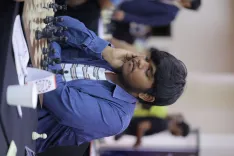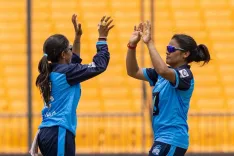Is Playing Later and Closer to the Body Better? Jaffer Advises Young Indian Test Batsmen

Synopsis
Key Takeaways
- Understanding Conditions: Batters must adapt to the unique English conditions that change frequently.
- Importance of Timing: Playing late and close to the body is essential for success against swing bowling.
- Openers' Role: A strong start from openers is crucial for building a solid innings.
- Mentorship: Experienced players must guide and mentor younger teammates.
- Focus on Footwork: Precise footwork is vital to avoid getting trapped in the crease.
New Delhi, June 19 (NationPress) The Indian Test batting lineup has historically faced challenges against England's swing and seam bowling, resulting in just three series wins for visitors over many years of touring the country. With Virat Kohli and Rohit Sharma having retired from Tests, the young Indian batters will undergo a significant test as the upcoming series kicks off at Headingley in Leeds on Friday.
Successfully navigating batting in England is straightforward in theory; however, Indian players have often struggled with patience, especially when the Dukes ball is swinging, which can further unsettle their performance. In the challenging swing bowling conditions of England, newly appointed captain Shubman Gill and his teammates will encounter rigorous tests of their batting techniques.
Wasim Jaffer, the former Indian opener who contributed to the team's 1-0 Test series victory in England in 2007, outlines the unique difficulties that arise when the series moves between different regions and venues.
“I believe that England is a place where conditions can change rapidly. When the sun shines, the conditions become quite flat; however, under overcast skies, the ball begins to move,” Jaffer stated in an exclusive interview with IANS.
“This variability is not common in other countries where conditions remain more stable, even during the summer months in England, which are often interrupted by rain. Moreover, each ground possesses its own unique characteristics - Lord's features a slope, while The Oval is known as a favorable batting wicket.”
“In the north, venues like Old Trafford and even Headingley, where the first Test will occur, are experiencing heat. This may allow for some favorable batting conditions; however, the ball still moves around a bit, providing assistance to bowlers. These are the challenges batters will encounter as conditions evolve,” he added.
Jaffer believes many players are accustomed to the rigors of a five-match Test series, drawing on their experiences in Australia, but he asserts that facing the same number of matches in England is a greater challenge. “In England, the Dukes ball continuously moves, requiring players to adopt a late batting style,” he noted.
“One must remember that in England, one can never comfortably assume, ‘I’m settled, so I will score big.’ The ball can begin to swing unexpectedly, and the Dukes ball also facilitates reverse swing,” he elaborated.
It will be crucial for the openers to ensure India has a solid start in their batting innings in England. When India led the series 2-1 in 2021, they succeeded largely due to the impressive performances of openers Rohit Sharma and KL Rahul, who faced over 1500 balls.
While Rahul managed a remarkable century in India's emphatic victory at Lord's, Rohit also contributed with a match-winning 127 at The Oval. Rahul excels in assessing the line and length of deliveries, demonstrating a knack for leaving balls, especially during the early stages of his innings. His combination of patience, sound technique, and temperament has led to positive outcomes in recent Tests.
With Rohit absent, Rahul must not only replicate his successful strategies from 2021 but also mentor his young opening partner Yashasvi Jaiswal, who is adapting to the challenges of opening in Tests in England after competing in the West Indies, South Africa, and Australia.
“The initial 30-45 minutes are crucial. You need to play a little late, avoiding unnecessary pokes at the ball. In England, there is lateral movement. Therefore, playing later and closer to the body is advantageous. Understanding your off-stump is vital since English bowlers typically target the off-stump or fourth stump,” Jaffer advised.
“Knowing where your off-stump is, determining which balls to play, and which to leave, alongside precise footwork, are essential. You don't want to be stuck in the crease. Whether advancing or retreating, you must capitalize on scoring opportunities when they arise,” he continued.
“These are aspects I am confident players who have spent ample time in England and engaged in practice matches will adapt to. The first Test is pivotal; if India performs well, it will instill confidence, which will prove beneficial,” Jaffer concluded, expressing optimism in the current lineup's potential for a successful tour.
Regarding Jaiswal, who showed mixed results in two India ‘A’ matches against England Lions with scores of 24, 64, 17, and 5, and tended to play away from his body, Jaffer remains hopeful after observing his performance against the Australian challenge. “The manner in which he scored runs in Australia was commendable, especially against their formidable bowling attack. He emerged successful,” he praised.
“Although he has yet to play in a Test match in England, he has experience through India U19 and ‘A’ teams. However, a Test match presents unique challenges, and I believe his technique and temperament will serve him well, as he aims to make a significant mark in his career,” he added.
Attention will also be on captain Shubman Gill, who will occupy the number four position, a role previously held by legends like Kohli, Sachin Tendulkar, Gundappa Viswanath, and Dilip Vengsarkar. One of Gill's noted issues in Tests has been his slow adjustment to playing on the front foot, which has led to fast bowlers nipping the ball back to dismiss him or trap him lbw.
Jaffer, the all-time leading run-scorer in the Ranji Trophy, was the Punjab head coach when Gill scored 102 against Karnataka in Bengaluru earlier this year – a performance where he had to temper his approach before accumulating runs. Jaffer believes that receiving the Test captaincy will aid Gill in improving his performance in overseas conditions.
“I sense that captaincy will not burden him; instead, it will challenge him to improve. Test cricket is a realm where he must enhance his statistics, particularly away from home, and this tour is significant. Knowing his character and temperament, I believe he is eager to score runs and win this series. Thus, captaincy may well enhance his batting,” he explained.
As India faces England, Jaffer highlighted that Joe Root is the key player India must target, even as others, including captain Ben Stokes, are experiencing inconsistent form.
“You cannot expect consistent assurance from everyone. Even Harry Brook has not amassed many runs recently, despite being an exciting player.”
“If India bowls effectively with Jasprit, Siraj, Prasidh, and Shardul, I believe India can apply pressure on the England batting lineup. This England side is relatively inexperienced, having lost Stuart Broad and James Anderson, creating an opportunity for India to pressure their bowling attack as well.”
“I predict a well-balanced series. It’s difficult to assert that England has the advantage while India is the underdog. India aims to assert themselves as a new team with fresh leadership, promising an exciting series ahead,” he concluded.







